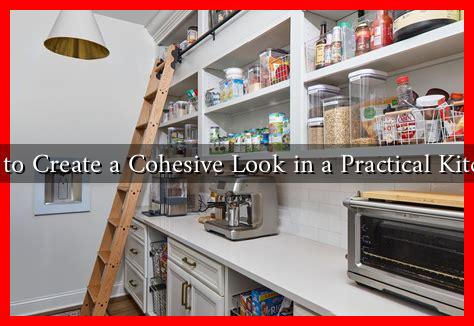-
Table of Contents
How to Create a Cohesive Look in a Practical Kitchen
The kitchen is often considered the heart of the home, a space where culinary creativity flourishes and family memories are made. However, achieving a cohesive look in a practical kitchen can be a challenge. With the right approach, you can create a space that is not only functional but also visually appealing. This article will guide you through essential tips and strategies to design a kitchen that harmonizes aesthetics and practicality.
Understanding the Importance of Cohesion
Cohesion in kitchen design refers to the seamless integration of various elements, including color, materials, and layout. A cohesive kitchen enhances the overall ambiance and makes the space more inviting. According to a survey by the National Kitchen and Bath Association, 70% of homeowners prioritize aesthetics when renovating their kitchens, highlighting the importance of a unified design.
Choosing a Color Palette
The color palette sets the tone for your kitchen. A well-thought-out color scheme can create a sense of harmony and balance. Here are some tips for selecting the right colors:
- Stick to a Limited Palette: Choose 2-3 main colors to avoid overwhelming the space. Neutral tones like whites, grays, and beiges can be paired with bolder accent colors.
- Consider the Mood: Warm colors (reds, oranges) can create an inviting atmosphere, while cool colors (blues, greens) promote calmness.
- Use Color Theory: Complementary colors (opposite on the color wheel) can create a striking contrast, while analogous colors (next to each other) provide a more subtle look.
Selecting Materials Wisely
The materials you choose for countertops, cabinets, and flooring play a significant role in achieving a cohesive look. Here are some considerations:
- Consistency is Key: Use similar materials across different surfaces. For example, if you choose quartz for your countertops, consider using the same material for a backsplash.
- Mix Textures: While consistency is important, mixing textures can add depth. Pair smooth surfaces with rougher ones, like a polished countertop with a rustic wooden table.
- Durability Matters: Opt for materials that are not only aesthetically pleasing but also practical. For instance, stainless steel appliances are both stylish and easy to maintain.
Creating Functional Zones
A practical kitchen should be designed with functionality in mind. Creating distinct zones can help streamline cooking and food preparation. Consider the following zones:
- Prep Zone: This area should include cutting boards, knives, and mixing bowls, ideally located near the sink and refrigerator.
- Cooking Zone: Place the stove, oven, and pots and pans in close proximity to enhance efficiency.
- Cleaning Zone: Ensure that the sink and dishwasher are easily accessible from both the prep and cooking zones.
Incorporating Lighting
Lighting is a crucial element in kitchen design that can significantly impact the overall look and feel. Here are some tips for effective kitchen lighting:
- Layered Lighting: Combine ambient, task, and accent lighting to create a well-lit space. For example, pendant lights over an island can provide task lighting while adding style.
- Natural Light: Maximize natural light by using sheer curtains or strategically placing mirrors to reflect light.
- Adjustable Lighting: Consider dimmer switches to adjust the mood based on the time of day or occasion.
Personal Touches and Accessories
Finally, adding personal touches can make your kitchen feel like home. Consider incorporating:
- Artwork: Hang framed prints or photographs that resonate with your style.
- Functional Decor: Use decorative jars, bowls, or utensils that are both beautiful and practical.
- Plants: Incorporate greenery with potted herbs or succulents to bring life to the space.
Conclusion
Creating a cohesive look in a practical kitchen involves careful planning and thoughtful design choices. By selecting a harmonious color palette, choosing the right materials, establishing functional zones, incorporating effective lighting, and adding personal touches, you can transform your kitchen into a space that is both beautiful and functional. Remember, the key is to balance aesthetics with practicality, ensuring that your kitchen not only looks great but also serves your culinary needs effectively. For more inspiration, consider visiting [Houzz](https://www.houzz.com) for design ideas and expert advice.


